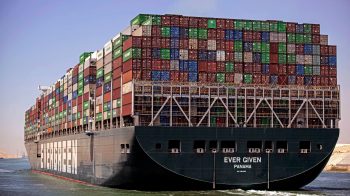
New vessels expected to lead to lower ocean shipping rates
New vessels expected to lead to lower ocean shipping rates

Ocean shipping rates have been surging in recent months. The diversion of container ships out of the Red Sea, a rush of early orders and bad weather have combined to double or triple prices. Those rates have come down slightly in the last few weeks, according to maritime research firm Drewry. And new ships coming online should help in the longer term.
Remember when we ordered so much stuff early in the pandemic that it helped break global supply chains? Ships were lined up at ports, nothing arrived on time, and shipping rates jumped eightfold. Well, that was a good time to be in the shipping industry.
“The ocean shipping lines made more money than they ever could have dreamed, I think, before the pandemic,” said Tim Denoyer, a senior analyst at ACT Research.
In 2022, shipping giant Maersk brought in $81.5 billion, more revenue than in any year. It’s net income went from around $5 billion in 2019 to nearly $31 billion in 2022. Across the industry, those profits were put to work.
“The ocean carriers have huge orderbooks of new ships,” said Ryan Petersen, CEO of logistics company Flexport. “And those were placed during the COVID boom years where they made so much money, they reinvested that in new ships, in new cargo, capacity.”
More ships — ships that take two and a half years to build.
Meanwhile, the boom years turned into bust years for the freight industry. After 2022, consumers had moved on from binging on patio furniture and new TVs, and retailers had too much stuff lying around, so they stopped ordering as much.
According to data from Freightos, the cost of shipping a container crashed from a peak of $11,000 down to a low of just about $1,000 toward the end of last year. Profits sank too. People called it “the Great Freight Recession.” The container ship orders, though? They were still there. Ships were being built.
“And those ships are being delivered. Every week we have ships coming online from the world’s shipbuilders,” said Petersen.
A record amount of shipping capacity was added in 2023. And as these ships started sailing, it seemed like the world was getting way more ships than it needed, according to Jean-Paul Rodrigue, professor of maritime business administration at Texas A&M Galveston.
“But now with the Panama issue, the Suez issue, this oversupply was captured, was accommodated,” he said.
The Panama Canal lowered its water levels this spring because of a drought; ships had to offload cargo to make it through. The Israel-Hamas war has spilled into the Red Sea, so shippers are avoiding the Suez Canal. Retailers all rushed to get holiday orders shipped early to avoid trouble later. And suddenly all those new ships were not enough — international trade needed more ships and more time.
The weighted average cost of shipping a 40-foot container went from $1,400 at the beginning of the year to nearly $6,000 now, according to maritime consultancy Drewry. The question for shippers is how long will this last.
“If this is a long-term situation, they might decide, ‘Yes, we need extra capacity,'” Rodrigue said.
Container ship owner Danaos Corporation recently announced it’s ordered five new container ships, due in 2027 and 2028. Meanwhile, other ships ordered years ago are still coming online, adding supply — all while demand is an open question.
So it looks like shipping rates will come down for 2025 and ocean freight in general may be headed for a bust year. And that, per Flexport’s Petersen, is kind of just how the shipping industry is.
“The ocean freight industry is inherently a boom-and-bust industry, because the asets last for like 30 years,” he said. “You know, you buy one of these ships and its got a really long life cycle.”
And it’s hard to predict trade patterns over just six months much less 30 years.
There’s a lot happening in the world. Through it all, Marketplace is here for you.
You rely on Marketplace to break down the world’s events and tell you how it affects you in a fact-based, approachable way. We rely on your financial support to keep making that possible.
Your donation today powers the independent journalism that you rely on. For just $5/month, you can help sustain Marketplace so we can keep reporting on the things that matter to you.

















